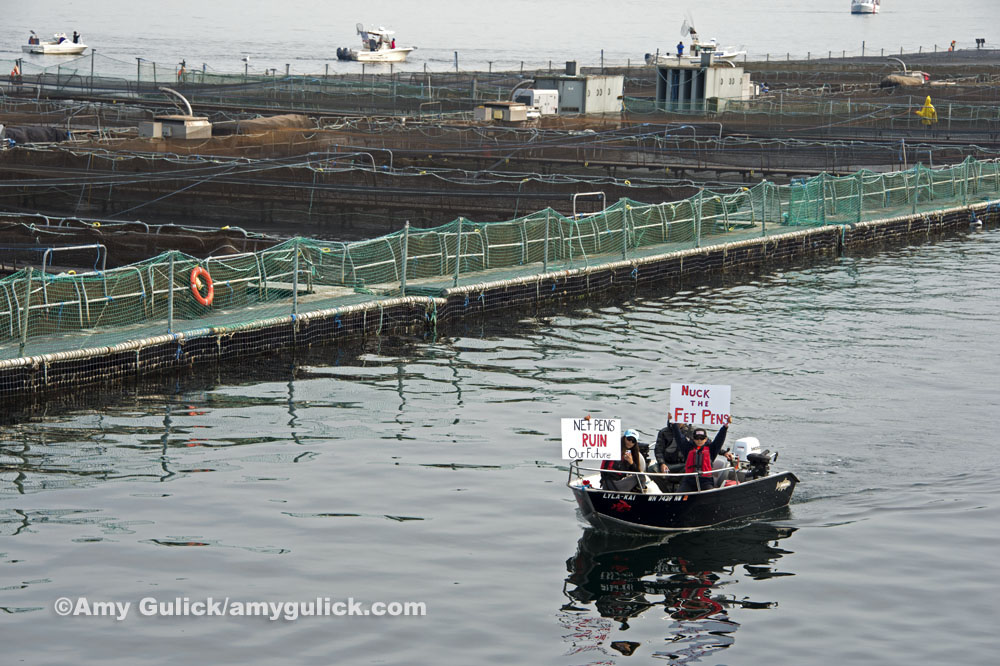It’s hard to be the voice of reason vs. billions in global sales. If you can’t compete with a colorful fan of international bills, good luck making your voice heard over the din of ca-chings.
Such is life for critics of open ocean net pens in Washington state (and indeed globally). Finfish aquaculture is a billion-dollar industry, and it’s controlled by companies much larger than most commercial fishing operations. No one wants to hear the complaints of the little guy being trod upon, even if he’s saying something valuable. So how can you fight it? Sometimes you have to wait for an accident. Cross your fingers that it’s just bad enough to get people’s attention but not enough to ruin your livelihood.
On Aug. 19 and 20, a salmon net pen owned by Cooke Aquaculture suffered a catastrophic collapse, releasing as many as 305,000 market-size Atlantic salmon into Washington’s Puget Sound (as of early October, the tally is still unknown). The pen had been documented as a failing structure in need of significant repair or replacement. The company was waiting to harvest the 3 million pounds of fish before making those repairs.
According to state records, Cooke acquired the pens in 2016 and in February 2017 filed a plan to repair or replace the failing structure. Reportedly, Cooke planned to complete the overhaul in September — seven months later — after cashing in the $10 million crop teeming away inside the failing pen.
What may have seemed like a good business decision at the time led to a catastrophic failure of the pen as well as Cooke’s optics and communications strategies, shining a spotlight on the worst of what open-ocean aquaculture has to offer — infiltration, potential spread of disease, and a lack of government oversight on the operations and reporting requirements.
Cooke Aquaculture reportedly waited three days after the first signs of collapse to notify the public. And when the company’s vice president of communications, Nell Halse, finally released a statement, she first blamed the failure on high tides and strong currents — which was later disproven by NOAA weather data — and claimed most of the fish were contained, also false. After three days of huddling around a public problem in private, you should at least have your story straight.
But even after suffering from the damaging optics of responding to a catastrophe with easily disproven falsehoods and dismissing the potential for damage to wild stocks, Cooke has not slowed its roll in the state of Washington. In fact, they have lawyered up for the fight to continue business as usual there.
After the spill, Washington Gov. Jay Inslee ordered a halt to all new mariculture permitting until the state can review threats to native species. He also requested that the company withdraw its proposal to put a fresh new batch of 1 million invasive salmon into an existing net pen (this one located at Clam Bay, which is the site of a recent protest). The Department of Fish and Wildlife released a statement on Tuesday, Oct. 3, saying it is not authorized to deny a permit to move healthy fish into an existing pen. The state investigated the company’s operations at Clam Bay thoroughly, but the investigating agencies could not find legal grounds to deny the permit.
The collapse of the Cooke pen in August coincided with the peak of the wild salmon spawning season, so any farmed fish that instinctively swam upstream were at the very least providing wild stocks with a competition for resources. And they had a three-day head start.
Yet, the Cooke spill could still be a gift to fishermen. Not in the Let Them Eat Cake way Halse suggested when she declared that the invasive salmon could be enjoyed by seals and fishermen alike. But this collapse and subsequent stocking is exposing the limits on public regulation of the private aquaculture industry in state waters. Wild fisheries are a public resource, and as such they should not be infringed upon by private industry without a public weigh-in.
I hope this disaster will result in a reasoned approach. Wild-capture fishing and aquaculture can coexist, but they must be either symbiotic or entirely separated. Seeding native or adaptive shellfish is about as different from open ocean net pens as you can get, and there’s a whole range in between on the aquaculture spectrum.
We must be clear that speaking out against open ocean net pens is not simply an opposition to competition for market value. It is an effort to protect the wild resource — a renewable public resource. You can’t put a market value on that, because it’s priceless.
This column is based on the Editor’s Log published in the November issue. It has been edited to reflect recent events in this ongoing story.







